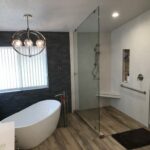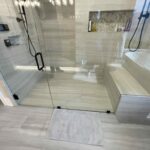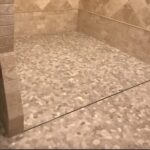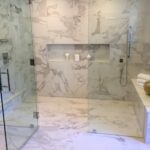When it comes to maintaining a pristine and durable bathroom, finding the right waterproof paneling for shower walls is essential. Proper waterproofing not only protects your walls from moisture damage but also enhances the overall look of your shower space. This guide will explore affordable and effective solutions for waterproofing, focusing on how shower wall panels can offer superior protection.
The Importance of Waterproof Paneling for Shower Walls
Waterproofing is a critical consideration when it comes to bathroom design, particularly for the shower area. The high moisture environment in a bathroom makes it susceptible to water damage, mold, and mildew if not properly protected. Shower walls, being in direct contact with water, require robust waterproofing solutions to maintain both the integrity and aesthetics of the bathroom.
Protect Your Investment
Shower walls are continuously exposed to water, steam, and humidity, making them highly susceptible to mold, mildew, and structural damage. Without proper waterproofing, these elements can lead to significant issues, such as water infiltration, which can damage the underlying structure, leading to expensive repairs. Waterproof paneling for shower walls acts as a protective barrier, preventing water from seeping behind the panels and ensuring that your shower area remains dry and damage-free.
Moreover, effective waterproofing extends the lifespan of your bathroom, preserving the quality of your investment. It prevents costly issues such as the deterioration of wall studs and insulation, which can result from water exposure over time. By choosing the right waterproof paneling, you not only protect your bathroom’s structural integrity but also avoid frequent and costly repairs.
Enhance Bathroom Aesthetics
Beyond functionality, waterproof paneling can transform your bathroom’s appearance. Available in various styles, colors, and finishes, these panels can be tailored to match your bathroom’s décor. Whether you prefer a modern, sleek look or a classic design, waterproof paneling can elevate the visual appeal of your shower space.
The variety in design options means you can create a personalized bathroom that reflects your style. From glossy finishes that add a touch of luxury to matte textures that offer a more understated elegance, waterproof panels provide endless possibilities to enhance the aesthetics of your bathroom. Additionally, the clean lines and smooth surfaces of these panels contribute to a streamlined look, making the shower area a focal point of the bathroom.
Types of Waterproof Paneling for Shower Walls
Choosing the right type of waterproof paneling for your shower walls is crucial for both performance and aesthetics. Different materials offer unique benefits and challenges, so it’s essential to understand the options available.
1. Acrylic Shower Panels
Acrylic shower panels are a popular choice for homeowners due to their durability and low maintenance requirements. Made from high-quality plastic, these panels are resistant to water and stains and offer easy installation and cleaning.
Advantages:
- Moisture Resistance: Acrylic panels are inherently water-resistant, making them ideal for use in wet environments like bathrooms.
- Low Maintenance: These panels require minimal upkeep, typically only needing a simple wipe-down with a non-abrasive cleaner to maintain their appearance.
- Design Variety: Available in various colors and designs, acrylic panels can mimic the look of more expensive materials like stone or tile, offering aesthetic flexibility.
Disadvantages:
- Scratching: While durable, acrylic can scratch more easily than some other materials, which may affect its appearance over time.
- Perceived Value: Acrylic panels may lack the premium feel of materials like glass or natural stone, which might be a consideration depending on your design goals.
Acrylic panels are ideal for those looking for a balance between cost, durability, and design flexibility. They offer an attractive solution that is easy to install and maintain, making them a favorite among DIY enthusiasts.
2. PVC Shower Panels
PVC (polyvinyl chloride) shower panels offer a cost-effective solution for waterproofing. These lightweight panels are highly resistant to water and are simple to install, saving both time and money.
Advantages:
- Affordability: PVC panels are one of the most cost-effective waterproofing options available, making them accessible for budget-conscious homeowners.
- Lightweight: The lightweight nature of PVC makes these panels easy to handle and install, which can significantly reduce labor costs.
- Ease of Installation: PVC panels can often be installed directly over existing surfaces, further simplifying the installation process.
Disadvantages:
- Durability: While water-resistant, PVC panels may not be as durable as other materials, particularly in high-traffic areas.
- Limited Design Options: PVC panels are available in fewer design options compared to other materials, which may limit customization.
PVC panels are particularly suitable for budget-conscious homeowners or those looking for a quick and easy installation. However, they may not offer the same longevity or design versatility as some other materials.
3. Fiberglass Shower Panels
Fiberglass shower panels are known for their strength and durability, making them suitable for high-traffic bathrooms. These panels can also mimic the look of natural stone or tile, providing a high-end appearance at a lower cost.
Advantages:
- Durability: Fiberglass panels are highly durable and can withstand daily wear and tear, making them ideal for busy households.
- Low Maintenance: Like acrylic, fiberglass requires minimal maintenance, with a simple cleaning routine keeping them in top condition.
- Variety of Finishes: Fiberglass panels can be finished in a variety of styles, including those that replicate the appearance of more expensive materials like stone.
Disadvantages:
- Higher Cost: Compared to acrylic or PVC, fiberglass panels can be more expensive, though they offer superior durability.
- Professional Installation: While not always necessary, fiberglass panels often require professional installation to ensure proper fitting and sealing, which can add to the overall cost.
Fiberglass panels offer a great middle ground for those seeking durability and a high-end look without the price tag of natural materials. They are particularly well-suited for families or high-traffic bathrooms where resilience is key.
4. Glass Shower Panels
Glass shower panels are a stylish choice for contemporary bathrooms. They offer a sleek, transparent look that can make your shower area appear larger and more open. However, glass panels require regular cleaning to maintain their clarity.
Advantages:
- Modern Aesthetics: Glass panels provide a clean, modern look that enhances the feeling of space in a bathroom.
- Light Reflection: The reflective properties of glass can make a bathroom appear brighter and more open, which is particularly beneficial in smaller spaces.
- Personnalisation : Glass panels can be frosted, tinted, or etched to add privacy or a decorative touch.
Disadvantages:
- Maintenance: Glass panels require regular cleaning to prevent water spots and soap scum from dulling their clarity.
- Higher Cost: Glass is typically more expensive than other waterproofing materials, both in terms of material and installation costs.
Glass panels are ideal for homeowners looking to create a sleek, modern bathroom. They are particularly effective in smaller bathrooms where maximizing light and space is essential.
5. Tile Shower Panels
Tile shower panels provide a classic and timeless look. While tiles themselves are not waterproof, they can be used with waterproof backing materials to offer effective protection. Tile panels are highly customizable and can be arranged in various patterns to match your design preferences.
Advantages:
- Customizable: Tiles offer a vast array of design possibilities, allowing homeowners to create unique patterns and color schemes.
- Durable: High-quality tiles are extremely durable and can last for decades with proper maintenance.
- Timeless Appeal: Tiles have a classic look that never goes out of style, making them a long-term investment for your bathroom.
Disadvantages:
- Grout Maintenance: The grout between tiles can be prone to staining and mold growth, requiring regular maintenance.
- Complex Installation: Tile installation is more complex than other paneling options and often requires professional installation.
Tile panels are a great choice for those who prioritize aesthetics and are willing to invest in regular maintenance. They offer unparalleled design flexibility and can be used to create a truly customized bathroom.
How to Choose the Best Waterproof Paneling for Shower Walls
Selecting the right waterproof paneling for your shower walls involves several key considerations, including budget, durability, maintenance, design, and installation requirements. Here’s how to navigate these factors to make the best choice for your bathroom.
Consider Your Budget
Your budget will significantly influence your choice of waterproof paneling for shower walls. Acrylic and PVC panels are generally more affordable, making them a good option for those looking to minimize costs. On the other hand, fiberglass and glass options may be pricier, but they offer additional benefits in terms of durability and aesthetics.
When budgeting, it’s important to consider both the upfront costs and the long-term value of the materials. While more expensive options like glass or tile may have a higher initial cost, they often provide better durability and a higher-end appearance, which can add value to your home. Conversely, more affordable options like PVC may require replacement sooner, potentially offsetting the initial savings.
Evaluate Durability and Maintenance
Durability is a crucial factor when selecting waterproof paneling. Bathrooms are high-traffic areas, and the paneling you choose needs to withstand daily use. Acrylic and fiberglass panels are known for their durability and ease of maintenance, making them excellent choices for busy households.
Glass and tile panels, while also durable, require more maintenance to keep them looking their best. Glass panels need regular cleaning to prevent water spots and soap scum, while tile panels require ongoing grout maintenance to prevent mold and staining. If you prefer a low-maintenance solution, acrylic or fiberglass might be more suitable.
Assess Design Preferences
The design of your shower area can heavily influence your choice of paneling. Consider the overall aesthetic of your bathroom and select panels that complement your existing décor. For example, if you prefer a sleek, modern appearance, glass or high-gloss acrylic panels may be ideal. If you lean towards a more traditional or rustic style, tile panels offer a wide range of patterns and textures that can enhance the look of your bathroom.
It’s also important to think about the long-term appeal of your chosen design. Trends in bathroom design can change, so opting for a more classic or neutral style might be wise if you’re concerned about resale value.
Installation Considerations
Different types of waterproof paneling have varying installation requirements. Acrylic and PVC panels are generally easier to install and may be suitable for DIY projects. These materials can often be installed directly over existing surfaces, which can save time and money.
On the other hand, glass and tile panels may require professional installation to ensure proper fitting and sealing. Improper installation of these materials can lead to water damage, so it’s crucial to factor in the cost and complexity of installation when making your decision.
Benefits of Waterproof Paneling for Shower Walls
The benefits of waterproof paneling for shower walls extend beyond just keeping your bathroom dry. These panels offer several advantages that make them a smart investment for any homeowner.
Prevent Mold and Mildew
One of the main benefits of waterproof paneling for shower walls is its ability to prevent mold and mildew growth. By creating a moisture barrier, these panels reduce the risk of mold and mildew, which can lead to health issues and unpleasant odors. Mold and mildew thrive in damp environments, so having a waterproof surface in your shower area is essential for maintaining a healthy bathroom.
Waterproof panels are particularly effective in preventing water from seeping into the walls, where it can create a breeding ground for mold. By sealing off the wall surface, these panels help keep your bathroom environment clean and healthy.
Easy Maintenance
Waterproof panels are designed for easy cleaning and maintenance. Unlike traditional tile grout, which can be prone to staining and mold, waterproof panels typically require only a simple wipe-down to keep them looking fresh. This ease of maintenance is particularly beneficial in busy households where time for cleaning is limited.
For those who prefer minimal upkeep, materials like acrylic and fiberglass are ideal. These panels are non-porous, meaning they don’t absorb water or stains, which makes them resistant to mold and mildew. This not only keeps your shower looking pristine but also reduces the time and effort needed to maintain it.
Cost-Effective Solution
While the initial cost of waterproof paneling can vary, it often proves to be a cost-effective solution in the long run. By preventing water damage and reducing maintenance needs, these panels can save you money on repairs and upkeep. In addition, their durability means they won’t need to be replaced as frequently as less robust materials, further enhancing their cost-effectiveness.
In terms of value for money, waterproof panels offer a compelling combination of durability, aesthetics, and ease of maintenance. They protect your bathroom from the costly effects of water damage while also enhancing its appearance, making them a smart long-term investment.
Preparation
Before installing waterproof paneling, ensure that the wall surface is clean, dry, and free from any previous materials or adhesives. Proper preparation is essential for a smooth installation and helps the panels adhere better. This step is crucial for preventing future issues such as water infiltration or poor adhesion.
If you’re installing over existing tiles, make sure they are in good condition, with no cracks or loose tiles. You may need to sand down the surface slightly to help the adhesive stick better. For new installations, make sure the wall is flat and even to avoid any gaps between the panel and the wall.
Measuring and Cutting
Accurate measurements are crucial for a successful installation. Measure the dimensions of your shower walls carefully and cut the panels to fit precisely. It’s important to measure twice to avoid costly mistakes. Use a sharp utility knife or a fine-toothed saw to make clean cuts in the paneling material.
If you’re unsure about cutting the panels yourself, consider seeking professional assistance. An experienced installer can ensure that the panels are cut to the exact dimensions of your shower area, resulting in a better fit and a more professional finish.
Adhesive and Sealing
Use a high-quality adhesive designed for waterproof applications to secure the panels to the wall. Make sure all seams and edges are properly sealed to prevent water from seeping behind the panels. The adhesive should be applied evenly to avoid any air pockets, which can compromise the panel’s ability to adhere properly to the wall.
For added protection, apply a silicone sealant around the edges of the panels, particularly at the joints and corners where water is most likely to penetrate. This will help create a watertight seal that protects your walls from moisture damage.
Regular Maintenance
After installation, maintain the panels by cleaning them regularly and checking for any signs of damage. Address any issues promptly to ensure the longevity and effectiveness of the waterproofing. Regular maintenance includes wiping down the panels to remove any soap scum or mineral deposits and inspecting the seals for any signs of wear or damage.
If you notice any cracks or gaps in the seals, reapply silicone to prevent water from getting behind the panels. Keeping up with regular maintenance will help extend the life of your waterproof paneling and keep your shower looking its best.
Choose the Best Waterproofing Solution for Your Shower
Selecting the right waterproof paneling for shower walls is crucial for protecting your bathroom and enhancing its appearance. Whether you choose acrylic, PVC, fiberglass, glass, or tile panels, each option offers unique benefits to suit different needs and budgets.
For personalized recommendations and to explore the best waterproofing options available, contact Hydoblok today. Our team of experts can help you find the ideal solution for your shower walls and ensure a seamless installation process.
Don’t wait to protect your shower walls with high-quality waterproof paneling. Visit our Shower Wall Panels and Building Panels categories to discover the best products for your needs.
For expert advice and a free quote, contact Hydoblok now and take the first step toward a watertight and beautiful bathroom.






Partagez cet article
Choisissez votre plate-forme :